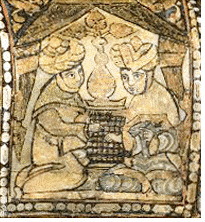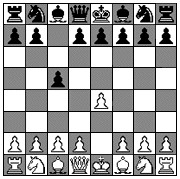...Best of Sicily presents... Best of Sicily Magazine. ... Dedicated to Sicilian art, culture, history, people, places and all things Sicilian. |
by Vincenzo Salerno | ||
Magazine Index Best of Sicily Arts & Culture Fashion Food & Wine History & Society About Us Travel Faqs Contact Map of Sicily |
Medieval Muslims sometimes attributed an almost "mystical" importance to chess, though their pieces, in keeping with Islamic theology, avoided the use of human figures. This changed with the Normans, whose chess pieces were based on actual personages. Theories about the spread of chess to Europe abound. Given their contact with the societies of France, Germany and England, there is little doubt that the Normans of Sicily influenced the propagation of the game in Europe. It also appears that European crusaders in Palestine and Asia Minor brought the game home with them. An early Sicilian image of chess (shown here) being The flexible and powerful opening and defensive tactics referred to as "The Sicilian" (shown in our diagram) were introduced in eighteenth century Naples. By that time, various features of "modern" chess had been incorporated into the game --notably castling, the moves of the queen, the en passant moves of the pawn. Medieval Sicilian society remains little more than a footnote to the fascinating general history of chess, but an interesting one nonetheless. About the Author: Palermo native Vincenzo Salerno has written biographies of several famous Sicilians, including Frederick II and Giuseppe di Lampedusa. | |
Top of Page |
 The origins of chess are clearly rooted in similar games played in
China and India, but the chess that we know today is based largely
on the medieval form that made its way into Persia, the Byzantine
Empire, Arabia and, finally, Europe, evolving slightly at each
geographical step. The word chess itself derives from the
French eschecs and the Late Latin scaccus (from
which the Italian scacchi), probably from the Persian shah
(king). The medieval Persians called the game "shatranj."
It is probable that the Byzantines brought the game to the Balkans
and Italy shortly following the fall of the (western) Roman Empire,
and early chess pieces have been discovered in places like Albania,
but it was the Arabs who popularized it in Sicily.
The origins of chess are clearly rooted in similar games played in
China and India, but the chess that we know today is based largely
on the medieval form that made its way into Persia, the Byzantine
Empire, Arabia and, finally, Europe, evolving slightly at each
geographical step. The word chess itself derives from the
French eschecs and the Late Latin scaccus (from
which the Italian scacchi), probably from the Persian shah
(king). The medieval Persians called the game "shatranj."
It is probable that the Byzantines brought the game to the Balkans
and Italy shortly following the fall of the (western) Roman Empire,
and early chess pieces have been discovered in places like Albania,
but it was the Arabs who popularized it in Sicily. played can be seen in the Normans' Palatine
Chapel in Palermo. Completed around 1140, the wooden ceiling in
Arabic style shows a painting of two men in turbans playing chess.
In some parts of Europe chess was regarded as an aristocratic
pursuit, its playing even forbidden to the low-born, but this
does not seem to have been the case in Sicily, where the conquering
Normans left many established Saracen social institutions in tact.
played can be seen in the Normans' Palatine
Chapel in Palermo. Completed around 1140, the wooden ceiling in
Arabic style shows a painting of two men in turbans playing chess.
In some parts of Europe chess was regarded as an aristocratic
pursuit, its playing even forbidden to the low-born, but this
does not seem to have been the case in Sicily, where the conquering
Normans left many established Saracen social institutions in tact.